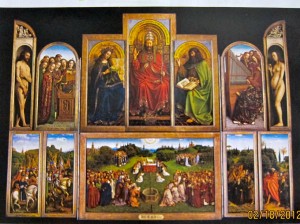Pinky says: The Ghent Alter Piece — A Hinge Painting
One of my great joys is to see the magnificent works of art “in the flesh” that I studied and lectured about over the years. One of the great downers for my husband has been to visit works of art in all the churches and museums of the world. We were in Bruges, which he refers to as a fantastic Disneyland for adults, and I asked him whether we might go to Ghent to see the altarpiece in St. Bavo. He said we could go although he was really satiated on hinge paintings. By this he meant works that open and close and have a number of panel paintings within them depicting scenes from the life of Christ together with pious depictions of the donors of the work. After Bruges the city of Ghent is not particularly lovely or clean; we hit Ghent in the midst of a storm and headed for one of the greatest hinge paintings known to the world. The church was dark and gloomy and we came upon the altarpiece situated in a small chapel, and suddenly the world was bright and beautiful. My husband dropped his jaw and said that the color in the works was virtually alive and seemed almost wet. We were looking at the multi panelled Ghent Altarpiece, a 600 year old six-hinged polyptych work that is 12 feet high by 17 feet wide when fully opened. The work is believed to have been begun by Hubert van Eyck in the early 1420s and finished by Jan van Eyck, a revolutionary innovator who was at least as important to Northern European painting as Giotto had been to Italian painting. It literally took our breath away. The panels have definitely been proven to have come from the workshop of Jan van Eyck and the attribution of the entire work is normally credited to Jan with a questioning of the exact contribution of Hubert as well as the other members of the workshop.
It had been commissioned by a wealthy textile merchant and has resided in various locations in St. Bavo for 6 centuries except for a number of prudent removals–to rescue it from Protestant iconoclasts, from a fire and confiscations by French soldiers and by Hitler. The latter thief had the panels hauled to a castle in Bavaria and then to a salt mine in Austria from which it was rescued in 1942. In 1986 the work was relocated to a chapel in the church and placed in a huge aquarium like box of bulletproof, reflective greenish safety glass that renders it scarcely seeable. Fortunately we saw the work in 1985. It is considered the defining monument of the new realism of Northern Renaissance art and is regarded as both the foundation of a distinguished tradition and an exemplary achievement to challenge all later artists. One might justly describe it as encompassing the whole art of painting.
There is no more astounding work of art than the Ghent Altarpiece. It is the first really ambitious and consummate use of oil paint, and it marks the birth of realism as a guiding principle in European painting. Jan van Eyck’s glazes pool like liquid radiance across his pictures’ smooth surfaces trapping and releasing graded tones of light and shadow and huge portions of brilliant color. The figures have sculptural roundedness, warm flesh, splendid raiment and distinctive personalities that literally leap to the viewer’s eye. We were engulfed in details such as hands that touch and grip with pressures, masses of hair given depth and definition by a few highlighted strands. Overall, the pictures generate sweet and visual music. Two panels show lovely winged angels singing and playing instruments and some scholars have said the notes they sing are discernible from the shapes of their mouths; an organ is so detailed that organists could recognize its sounds. Adam and Eve are depicted resplendent in their nakedness and seem to project out of the depths of their niches into real space. Typical of Netherandish painting of the period Eve has a protruding stomach which signifies fertility and style rather than pregnancy.
Even the arrangement –there are two ranks of panels, as if of two altarpieces stacked–is a format unique in art history. One panel was stolen in 1934, and is replaced by a bland copy, but the overall magic of the work overpowers any misgivings about the astonishing realism of the figures, plants, and animals. The lower level is a continuous heavenly landscape, verdant and rich through which a multitude of figures travel on horseback and on foot to adore the mystic Lamb of God on the central altar. There are clerics, pagan philosophers, martyrs, saints and angels approaching the altar. The lamb, whose blood flows into a chalice symbolizes the sacrifice of Christ. A stream of crystal clear water tic trickles to the bottom of the panel from where it may have fallen to thirsty souls in Purgatory on a predella — a strip of small narrative scenes– that was lost sometime before 1568. An art historian of the time lamented its ruin by restorers with “calf hands”. The complex theological program is based on the liturgy for All Saints Day, however no single text has been found to “explain” the entire program. But that is an area of the work which does not interest me at all. It is the upper level which is both awe inspiring and confusing. Mary is seated to the the left and John the Baptist to the right of a central figure, a young enthroned and bejeweled male figure holding a crystal sceptre and raising two fingers in blessing either Christ or God. Who the middle figure is has never been established with any degree of certainty, however the three figures have a staggering sophistication. The intricacy and sumptuousness of the images are achieved with economical technique. Each of the hundreds of pearls that decorate Mary’s robes is just a dollop of gray hit with a spot of white. There is a seductive softness in the flesh of Mary’s throat which can be seen to be one long stroke indicating a crease of slightly varied flesh color. It is as if van Eyck understood that realism dos not require verisimilitude and needs only enough visual cues to fire the mind’s own abilities. His style is the result of training he received from manuscript illumination and the study of modelling of bodies and drapery of sculpture at that time.
The Ghent Altarpiece is the alpha and the omega of altarpiece painting. Viewing it is so overwhelming that I began to wonder what it would look like with perfect museum lighting, but then this will never come to pass. It will remain in some dark chapel or nook of St. Bavo that depends on the work to sustain the prestige and finances of the church. However, when I suggested that my husband might enjoy seeing the Isenheim Altarpiece, he advised me that once you have seen the greatest, there was no need to seek out other hinge paintings. He was finished with them.



Leave a Reply to joe kratchman Cancel reply